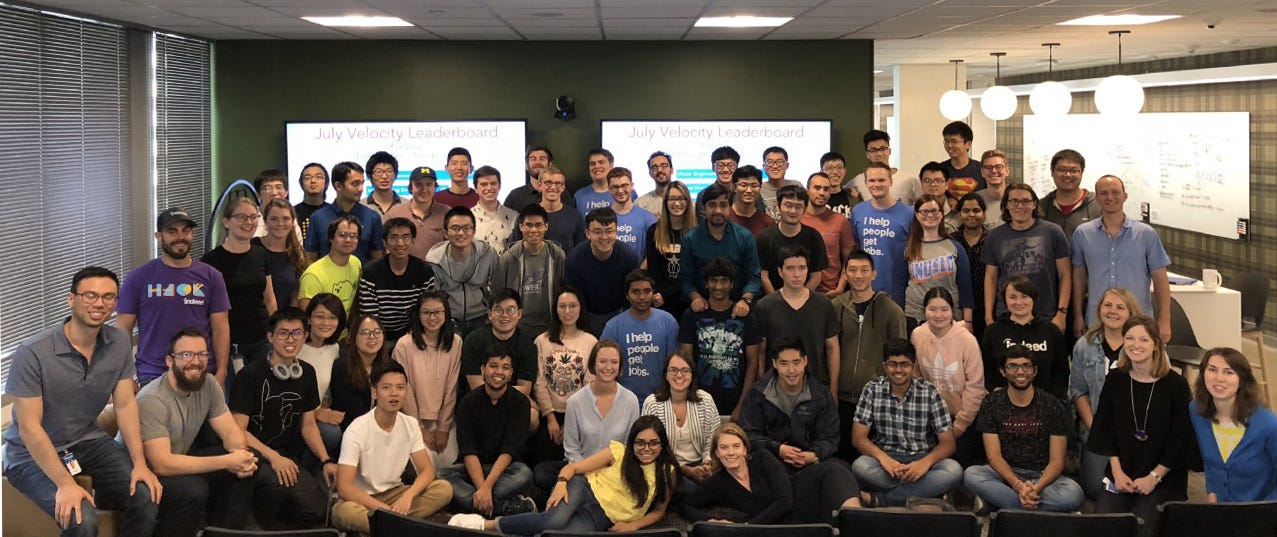A data scientist’s perspective on Indeed’s onboarding program.
What if — on your first day at a new job — you were given three months to build a product that helps people find jobs? (Something Indeed has spent 14 years developing!)
This is what I experienced when I attended Indeed University — Indeed’s onboarding program. At first I felt terrified. How could I contribute as a data scientist? Building a software product, especially during the early stages of development, might not yield enough data for most data science work.
Indeed expects full stack data scientists to help with the entire data science process, from collecting data and performing analysis to eventually deploying models in production. But writing React code and participating in discussions about how to build the logging infrastructure — expectations at Indeed U — is a whole different story.
Fortunately I was able to survive the program. In the process I gained valuable experience that otherwise I might never have had the chance to acquire.
What is Indeed University?
Indeed University (IU) is a three-month program for new Indeed employees who are fresh out of college. At the same time that IU gets new hires up to speed, it incubates new and innovative products for the company. Employees come from diverse disciplines, including Engineering, Product, Software Reliability Engineering, Data/Product Science, and Online Marketing.

Indeed University Participants and Leads, Seattle 2018
At the start of IU, anyone can pitch their new ideas. All ideas are welcome, as long as they aim to solve real problems for job seekers or employers. People then form teams based on the problems they most want to solve. Diverse teams consist of 3–5 new employees and senior employees as team leads. With a shared vision and real marketing dollars (to access tens of millions of real users), the group builds and tests a brand new product.
Products that prove their value can continue and those who’ve launched them have the chance to create a formal product team.
What did I helped build?
 Our team included two software engineers and me, a data scientist. Together, we built a product for job seekers facing career transitions. Our objective was to help these job seekers identify their next potential field. Our product asked users to name their current field, and then recommended new fields that were most relevant.
Our team included two software engineers and me, a data scientist. Together, we built a product for job seekers facing career transitions. Our objective was to help these job seekers identify their next potential field. Our product asked users to name their current field, and then recommended new fields that were most relevant.
Users were also provided skill requirements, salaries, the percentage of job seekers who have made similar transitions, and related information.
What role did I play on the team?
While being embedded in Indeed’s product teams means data scientists have opportunities to impact the team’s product decisions, brand new data scientists don’t usually start leading discussions on designing a product’s framework — or deciding the product’s next big initiatives. We can more typically expect responsibilities like exploratory data analysis, building models and deploying them.
In IU, the roles are a lot more flexible. As I anticipated, I designed A/B tests, did test analysis, and helped the team make data-driven decisions. I also acted as product manager, marketing analyst, UX researcher, and part-time front-end engineer. As a product manager, I was responsible for defining and tracking product metrics, and prioritizing work within the team. As a marketing analyst, I owned the marketing campaigns of our product on Google and Facebook as well as Indeed’s internal ads system. I designed the ads, budgeted our spending and made sure that we used our budget on the most effective channels. As a UX researcher, I created and launched surveys to get user feedback on our product. At times I even went out of the office and interviewed people.
Why participate in IU as data scientists?
Having data scientists at IU brings value to all involved. Data scientists have unique experience to offer, and IU offers us valuable first-hand knowledge that can be hard to gain elsewhere.
1. Observing data-driven decision making in action
At Indeed we want all our product decisions to be backed up by data. Through IU, I got a sense of what it truly means to “A/B test everything.” As my team’s IU product rapidly iterated, we were constantly faced with the question: “What feature should we add to our product next?” The easy answer is “whatever we liked most,” but the correct answer is to “prioritize based on effort and do A/B tests”! We should identify which features give the largest potential impact for the least amount of effort. Only those features that show impact in tests should be kept in production.
Rigorous A/B tests require a lot of data science effort, such as defining success metrics, defining A/B test requirements, and doing A/B test analysis. As our product evolved and our user base grew from the data-driven decisions we made, I saw how building a solid product takes engineering effort AND scientific effort, working together.
2. Learning how Indeed.com works
Even though our product attracted more than 20K users, we ended up not continuing with it because it was not performing as well as Indeed’s job search. We wanted to keep adding new features and providing as much information as possible to the users, thinking that more is always better. What we found out was that with more features comes a more complicated product. This inevitably means more users lose interest, because they are navigating through an increasingly intricate system.
We really learned to appreciate Indeed’s simple yet effective “what+where” job search interface. It turns out that Indeed really knows how to do its job well! As a more general rule, we found it is often more effective to focus on one feature and make it shine as opposed to building a large variety of different features.
3. Learning about the big picture
Data scientists’ work often starts with gathering data. Sometimes we might not get to look closely at what is behind all the data. How is it stored? Where does it come from? What architecture is in place for the data to be readily available? Building a product from scratch gives data scientists a chance to view the design and development process from a more holistic level. We are thus able to think about data science questions that derive from this process from a more critical point of view.
4. Building empathy
As data scientists, a lot of our work involves effective communication and collaboration with software developers, product managers, and other members of the team. Having been in their shoes, I have a much better understanding of what their work is like, and how a data scientist can make everyone else’s work easier.
5. Having fun!
Lastly, we got to have lots of fun! You might spend some late nights in the office — but this hard work is often accompanied by a variety of fun activities. No matter which city hosts IU, you have the opportunity to familiarize yourself with the area. IU schedules all kinds of activities for the teams throughout the entire program. Cruises, room escapes, fancy dinners, Go-Karts, VR challenges… you name it!
Just as in formal academic universities, in IU you get to meet and build close relationships with a group of people coming from all over the world. You get to see your ideas transform into real products and benefit real users. You get to go out of your comfort zone and practice skills that are outside of your expertise. If any of these sound interesting to you, check out our open positions for Data Scientist and Product Scientist at Indeed!
Learn more about Data Science at Indeed.




